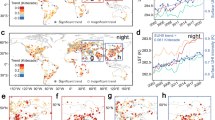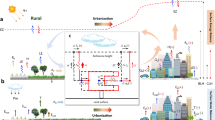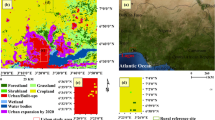Abstract
Kalnay and Cai1 claim that urbanization and land-use change have a major effect on the climate in the United States. They used surface temperatures obtained from NCEP/NCAR 50-year reanalyses (NNR) and their difference compared with observed station surface temperatures as the basis for their conclusions, on the grounds that the NNR did not include these anthropogenic effects. However, we note that the NNR also overlooked other factors, such as known changes in clouds and in surface moisture, which are more likely to explain Kalnay and Cai's findings. Although urban heat-island effects are real in cities, direct estimates of the effects of rural land-use change indicate a cooling rather than a warming influence that is due to a greater reflection of sunlight.
Similar content being viewed by others
Main
The NNR use upper-air observations to produce analyses of atmospheric fields every 6 hours by using four-dimensional data assimilation that capitalizes on available multivariate data. As a consequence of the procedures used, the NNR do not directly include local surface influences or observations. Therefore, land-use and urbanization effects may contribute to differences detected with high-quality, measured station surface temperatures.
In addition, the reanalyses do not include effects of the changing atmospheric composition on radiation, despite carbon dioxide concentrations in the atmosphere increasing from 318 p.p.m.v. in 1960 to more than 370 p.p.m.v. — an increase of about 17% — over this time. Neither do the reanalyses deal with changes in surface wetness. Increases in cloudiness and rainfall over the Mississippi River Basin have increased evaporation but decreased potential evapotranspiration2. These trends have an important influence on the surface-heat balance.
The NNR did not include cloud information, and the depiction of clouds in the NNR is poor and the surface-heat budget has serious errors3. Detailed studies of the surface-heat budget and of why minimum temperatures are increasing at a faster rate than maximum temperatures reveal that the decreasing diurnal temperature range (DTR) is linked to a worldwide increase in cloud cover4. Clouds reduce DTR by sharply decreasing surface solar radiation and reducing radiative heat losses at night.
Processes involved in DTR, including radiation, surface fluxes of sensible and latent heat, and soil-moisture effects, have been investigated by using comprehensive measurements from the First ISLSCP (International Satellite Land Surface Climatology Project) Field Experiment (FIFE) in Kansas4. Changes in clouds, especially low clouds, largely determine the patterns of change of DTR. Soil moisture also decreases DTR by increasing cooling through daytime surface evaporation. Empirical relationships4 using 3-hourly weather observations extend the results globally to show that DTR varies inversely with cloud cover and precipitation on several timescales, particularly over the United States. The reported decreases1 in DTR are therefore consistent with the observed increases in cloud cover.
Across the southern two-thirds of the eastern United States, the DTR peaks in spring and autumn, with minima in winter and mid- to late summer5. Changes in DTR are traceable to the lengthening growing season, especially on sunny days, indicating that the increases in vegetation and associated evapotranspiration are important.
However, a direct assessment of the effects of changes in land use and vegetation6,7 show that conversion of forests to crop land generally causes an increase in reflected sunlight that is greatest after the harvest in the autumn. The increased reflection results in a relative cooling, estimated to be in excess of 1 °C in autumn6, which is due to changes in land use rather than to warming1. After the 1960s, the greatest land-use changes have been in the increase in crop land area in the midwestern United States and in reforestation in the northeast6. By contrast, urban heat-island effects are localized in cities, whose stations are not used in compilations of climate change. Also, changing snow cover contributes to the decrease in DTR during winter in the United States8.
Changes in cloudiness and surface moisture are probably the main source of the discrepancies in trends found by Kalnay and Cai1. The NNR omit these influences in computing the surface-heat budget, although they are critical for getting surface-air temperatures right. Influences by processes not in the NNR model (including urbanization and land-use change) will be included in variables whose observations are analysed, but not in those variables calculated from the model (including surface-air temperature).
References
Kalnay, E. & Cai, M. Nature 423, 528–531 (2003).
Milly, P. C. D. & Dunne, K. A. Geophys. Res. Lett. 28, 1219–1222 (2001).
Trenberth, K. E., Caron, J. M. & Stepaniak, D. P. Clim. Dyn. 17, 259–276 (2001).
Dai, A., Trenberth, K. E. & Karl, T. R. J. Climate 12, 2451–2473 (1999).
Durre, I. & Wallace, J. M. J. Climate 14, 354–360 (2001).
Bonan, G. B. J. Climate 14, 2430–2442 (2001).
Myhre, G. & Myhre, A. J. Climate 16, 1511–1524 (2003).
Durre, I. & Wallace, J. M. J. Climate 14, 3263–3278 (2001).
Author information
Authors and Affiliations
Rights and permissions
About this article
Cite this article
Trenberth, K. Rural land-use change and climate. Nature 427, 213 (2004). https://doi.org/10.1038/427213a
Issue Date:
DOI: https://doi.org/10.1038/427213a
This article is cited by
-
Snow cover and vegetation greenness with leaf water content control the global land surface temperature
Environment, Development and Sustainability (2021)
-
Modeling of land-use and land-cover change impact on summertime near-surface temperature variability over the Delhi–Mumbai Industrial Corridor
Modeling Earth Systems and Environment (2021)
-
Spatiotemporal variability in spate irrigation systems in Khirthar National Range, Sindh, Pakistan (case study)
Acta Geophysica (2020)
-
Comparing daily temperature averaging methods: the role of surface and atmosphere variables in determining spatial and seasonal variability
Theoretical and Applied Climatology (2019)
-
Using multi-model ensembles to improve the simulated effects of land use/cover change on temperature: a case study over northeast China
Climate Dynamics (2016)
Comments
By submitting a comment you agree to abide by our Terms and Community Guidelines. If you find something abusive or that does not comply with our terms or guidelines please flag it as inappropriate.



